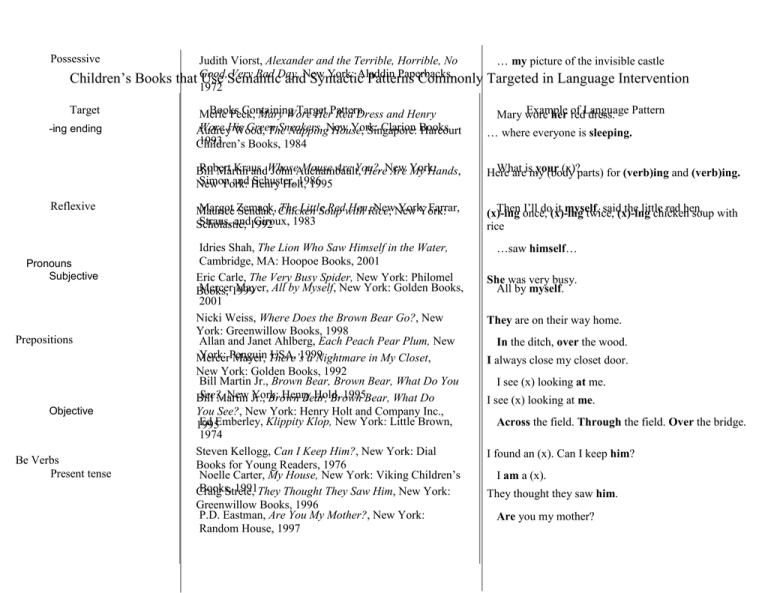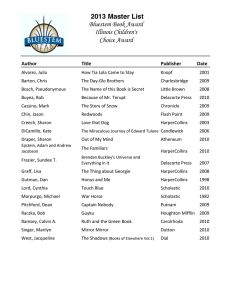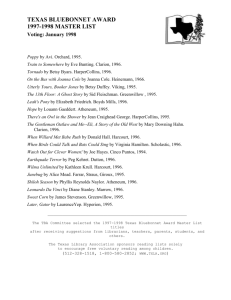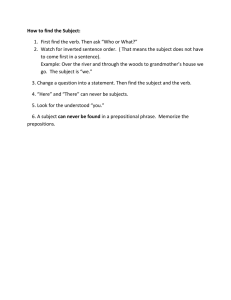Children’s Books that Use Semantic and Syntactic Patterns Commonly Targeted...
advertisement

Possessive Children’s Books Target -ing ending Reflexive Pronouns Subjective Prepositions Objective Be Verbs Present tense Judith Viorst, Alexander and the Terrible, Horrible, No Very Bad Day, York: Aladdin Paperbacks, that Good, Use Semantic andNew Syntactic Patterns Commonly 1972 … my picture of the invisible castle Targeted in Language Intervention Books Containing Target Merle Peek, Mary Wore HerPattern Red Dress and Henry Wore His Green Sneakers, New York: Clarion Books Audrey Wood, The Napping House, Singapore: Harcourt 1993 Children’s Books, 1984 … where everyone is sleeping. Robert Kraus, Mouse Are You?, Bill Martin andWhose John Auchambault, HereNew Are York: My Hands, Simon and Schuster, 1986 New York: Henry Holt, 1995 What your (x)?parts) for (verb)ing and (verb)ing. Here areismy (body Margot Zemack, The LittleSoup Redwith Hen,Rice, NewNew York: Farrar, Maurice Sendak, Chicken York: Straus, and Giroux, 1983 Scholastic, 1992 Then once, I’ll do(x)-ing it myself, said(x)-ing the little red hen. (x)-ing twice, chicken soup with rice Idries Shah, The Lion Who Saw Himself in the Water, Cambridge, MA: Hoopoe Books, 2001 Eric Carle, The Very Busy Spider, New York: Philomel Mercer1999 Mayer, All by Myself, New York: Golden Books, Books, 2001 Nicki Weiss, Where Does the Brown Bear Go?, New York: Greenwillow Books, 1998 Allan and Janet Ahlberg, Each Peach Pear Plum, New York: Penguin USA, 1999 Mercer Mayer, There’s a Nightmare in My Closet, New York: Golden Books, 1992 Bill Martin Jr., Brown Bear, Brown Bear, What Do You See?, New Jr., York: Henry Hold, 1995Bear, What Do Bill Martin Brown Bear, Brown You See?, New York: Henry Holt and Company Inc., Ed Emberley, Klippity Klop, New York: Little Brown, 1995 1974 Steven Kellogg, Can I Keep Him?, New York: Dial Books for Young Readers, 1976 Noelle Carter, My House, New York: Viking Children’s Books, 1991They Thought They Saw Him, New York: Craig Strete, Greenwillow Books, 1996 P.D. Eastman, Are You My Mother?, New York: Random House, 1997 Example Mary wore her of redLanguage dress. Pattern …saw himself… She was very busy. All by myself. They are on their way home. In the ditch, over the wood. I always close my closet door. I see (x) looking at me. I see (x) looking at me. Across the field. Through the field. Over the bridge. I found an (x). Can I keep him? I am a (x). They thought they saw him. Are you my mother? Past tense (be) (verb) ing Verb Vocabulary Mikhail Baryshnikov, Because…, New York: Athenum Books for Young readers, 2007 This is me. I live over there in that red house. Eric Carle, The Very Hungry Caterpillar, New York: Putman Publishing Group, 1994 But he was still hungry. Lois Ehlert, Read Leaf, Yellow Leaf, San Diego: Harcourt Brace and Company, 1991 The wind blew. They twirled and whirled. Ruth Krauss, The Carrot Seed, Mexico: Harper Festival, 1993 A little boy planted a seed. Lydia Dabkovich, Sleepy Bear, New York: Puffin Books, 1985 The birds are leaving. Margaret Wise Brown, The Runaway Bunny, New York: HarperCollins, 2005 I am running away. Paul Galdone, Henny Penny (folktale), New York: Houghton Mifflin, 1979 Where are you going? Allison Lester, Clive Eats Alligators, New York: Houghton Mifflin Co., 1991 Clive eats… Laurie Lazzaro Knowlton, Why Cowboys Sleep with Their Boots On, Gretna, LA: Pelican Publishing Company, 1995 Lassoed, branded, stripped, crawled John Burningham, Skip Trip, New York: Viking Children’s Books, 1984 Illustrated action words. Charlotte Zolotow, Do you Know What I’ll Do?, New York: Harper Collins publishers, 2000 I’ll pick you a bunch… Modal auxiliaries Negatives Questions Do insertion Dr. Seuss, Mr. Brown Can Moo, Can You?, New York: Random House, 1996 Mr. Brown can (verb), can you? Jean Marzollo and Jerry Pinkney, Pretend You’re a Cat, New York: Dial Books for Young Readers, 1997 Can you (action verb)? Charles G. Shaw, It Looked Like Spilt Milk, New York: HarperCollins Children’s Books, 1993 It wasn’t (x). Dr. Seuss, Green Eggs and Ham, New York: Random House, 1999 I do not like them. Paul Galdone, The Gingerbread Boy (folktale), New York: Houghton Mifflin Company, 1983 They couldn’t (x). You can’t (x). Ann Rockwell, In Our House, New York: HarperCollins, 1991 What do we do? Ben Shecter, When Will the Snow Trees Grow?, New York: HarperCollins Children’s Books, 1993 When… and Margot Zemach, The Little Red Hen (folktale), New York: Farrar, Straus, and Giroux, 1993 Who will (action) this (object)? Who will harvest this wheat? Who will plan this wheat? Nicki Weiss, Where Does the Brown Bear Go?, New York: Greenwillow Books, 1998 Where does the (x) go? Robert Lopshire, ABC Games, New York: Harper Collins Children’s Books, 1986 Which one will (x)? Where is the (x)? Stan and Jan Berenstain, The Berenstain Bears and the Spooky Old Tree, New York: Random House, 1997 Do they dare (x)? Nancy Hellen, The Bus Stop, New York: Orchard Books, 1988 Can you see the bus yet? Shigeo Watanabe, Where’s My Daddy?, New York: Putnam Publishing Group, 1996 Have you seen my daddy? Maurice Sendak, One Was Johnny, New York: HarperCollins Children’s Books, 1991 …who lived by himself… P. Adams, There Was an Old Lady Who Swallowed a Fly, New York: Child’s Plan, 1989 …who swallowed a fly… who swallowed a spider… Liza Baker, I Love You Because You’re You, New York: Scholastic, 2001 I love you when you’re happy… If clause Laura Numeroff, If You Give a Mouse a Cookie, New York, HarperCollins Childrens Books, 1997 … then he’ll want a glass of milk. But clause Mercer, Mayer, Just For You, New York: Golden Books Family Entertainment, 1982 I wanted to X, but… Laurel Portet-Gaylord, I Love Daddy Because, New York: Dutton Childrens Books, 1991 I love (x) because… Yes/no Have auxiliary Complex Sentences Relative clauses Wh complement Because clause Adapted from Kirchner, D. (1991). Reciprocal book reading: A discourse-based intervention strategy for the child with atypical language development. In T. Gallagher (Ed.), Pragmatics of language: Clinical practice issues (pp.307-332). San Diego, CA: Singular Publishing Group; Owens, R. (2009). Language disorders: A functional approach to assessment and intervention (4th ed.). Boston, MA: Allyn & Bacon; Ratner, N., Parker, B., & Gardner P. (1993). Joint book reading as a language scaffolding activity for communicatively impaired children. Seminars in Speech and Langauge, 14, 296-313. Paul, R. (2012). Language disorders from infancy through adolescence: Listening, Speaking, Reading, Writing, and Communicating (4th ed., pp. 388-392). St. Louis, Missouri: Mosby.





